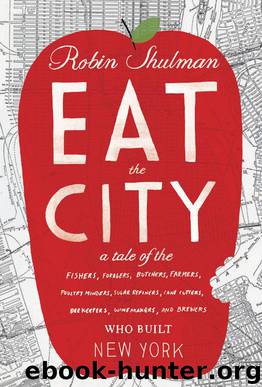Eat the City by Robin Shulman

Author:Robin Shulman
Language: eng
Format: mobi, epub, pdf
ISBN: 9780307719072
Publisher: Crown Publishing Group
Published: 2012-07-09T22:00:00+00:00
JORGE Torres is an expert in how to eat cane. First, it has to be cut—he gets out a machete stashed in the casita, poises his right hand, slashes—into a length you can hold. Then its thick bark has to be removed, so he uses the machete as a vertical peeler, hacking all around the stalk, revealing a wet, white center that looks something like the flesh of an apple. You have to bite that fibrous middle to release a bit of juice, and suck and chew and knead out more. It’s not as intense as a spoonful of white table sugar, but has a light, fresh, lingering sweetness.
For hundreds of years while sugar refining was big business in New York City, you might have been hard-pressed to find a piece of cane to suck outside of the odd import in Chinatown. But when people from the Caribbean came, they wanted their caña. “Out of huge barrels loom red sugar cane, six or eight feet high, which later, cut in short lengths, is eaten as stick candy by children,” wrote a visitor to Harlem in 1928. As generations of Puerto Ricans continued to settle in the city, Jewish merchants at East Harlem’s markets began to stock tropical produce.
When his children were young, Jorge Torres would go to the bodegas near his Bronx apartment, with their bins and boxes of fading sugarcane, prehistoric yucas, blackening mangoes and plantains and papayas—enough mottled imports for every household between the Cross Bronx Expressway and the Bronx Zoo to produce some pale version of a tropical diet. He brought the cane home to his children, but it had aged in its travels from Puerto Rico. “Old sugarcane smells bad and tastes bitter,” Jorge said, and its pure white flesh becomes reddish. The stuff available at the bodegas was, in his assessment, “worthless.”
Why the impulse to grow cane struck when it struck is hard to explain. “I like the taste, I like the way it looks,” Jorge says. “I like to give it away.” Sugarcane juice is good for the kidneys and for blood pressure, he says. “Sugarcane is healthy and it makes you grow,” he insists, ignoring all evidence of tooth decay, obesity, type 2 diabetes. People are still shocked when he takes out a machete and slices through the stalks on his windowsill nursery to retrieve some cane for the kids to chew. One day, his brother came over with a camera phone to make a video of the cane to put online.
Back in Puerto Rico, the area where Jorge cut sugarcane is now filled with sidewalks and highways and houses. Yet some people on the island, and Puerto Ricans like Jorge in New York, still remember how a man might say a girl is like sugarcane in February—the time of year when the cane is barely mature and the sweetest for plucking. You’re sweeter than molasses, a man might say to a woman. You wiggle more than sugarcane in the wind, a parent might tell to a restless child.
Download
Eat the City by Robin Shulman.epub
Eat the City by Robin Shulman.pdf
This site does not store any files on its server. We only index and link to content provided by other sites. Please contact the content providers to delete copyright contents if any and email us, we'll remove relevant links or contents immediately.
Whiskies (Collins Gem) by dominic roskrow(42333)
101 Whiskies to Try Before You Die by Ian Buxton(42298)
Whiskies Galore by Ian Buxton(40555)
Craft Beer for the Homebrewer by Michael Agnew(17466)
Right Here, Right Now by Georgia Beers(3515)
Not a Diet Book by James Smith(2746)
Water by Ian Miller(2601)
The Coffee Dictionary by Maxwell Colonna-Dashwood(2548)
Kitchen confidential by Anthony Bourdain(2325)
Coffee for One by KJ Fallon(2020)
Smuggler's Cove: Exotic Cocktails, Rum, and the Cult of Tiki by Martin Cate & Rebecca Cate(1997)
Beer is proof God loves us by Charles W. Bamforth(1941)
Superfood Smoothie Bowls: Delicious, Satisfying, Protein-Packed Blends that Boost Energy and Burn Fat by Chace Daniella(1920)
Talking as Fast as I Can by Lauren Graham(1853)
Bourbon: A Savor the South Cookbook by Kathleen Purvis(1805)
A Short History of Drunkenness by Forsyth Mark(1735)
Eat With Intention by Cassandra Bodzak(1700)
Cocktails for the Holidays by Editors of Imbibe magazine(1640)
Colombia Travel Guide by Lonely Planet(1624)
